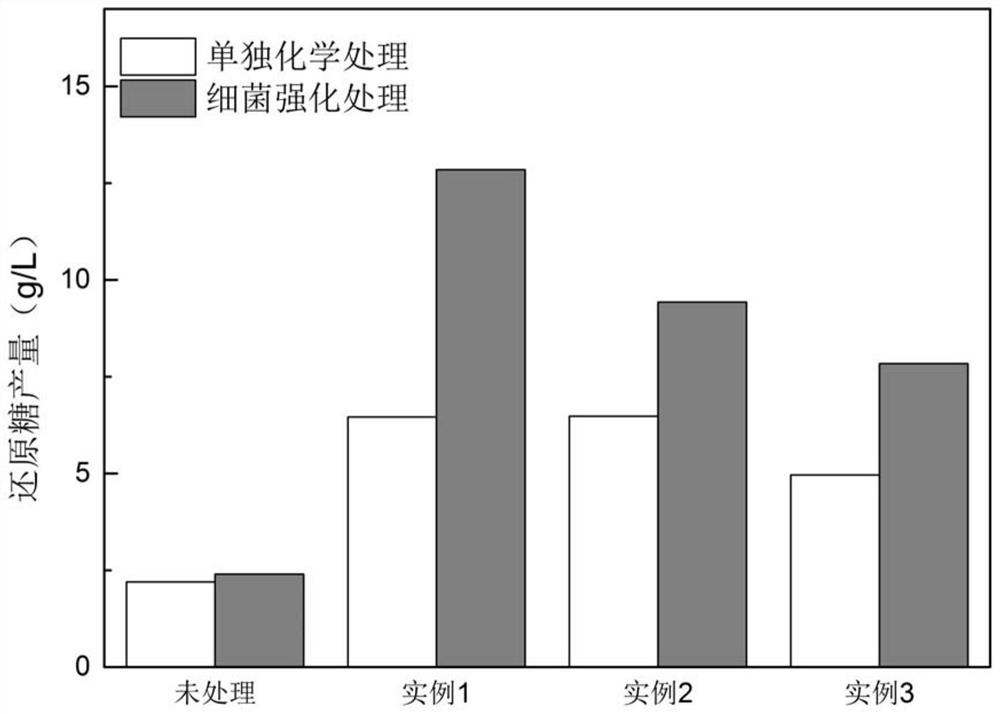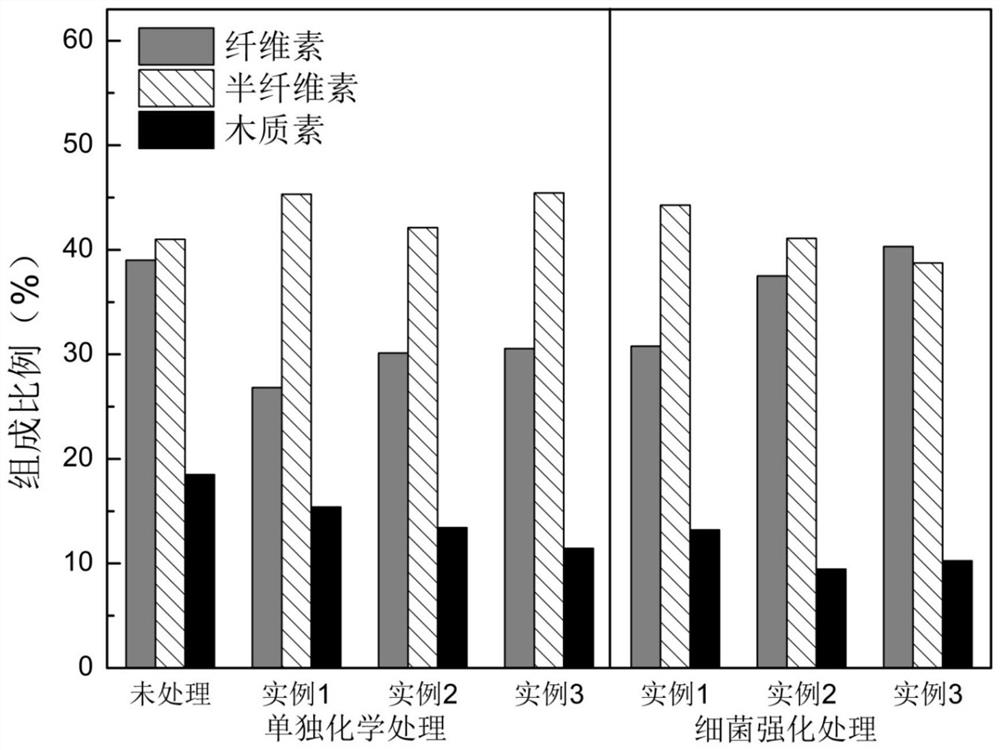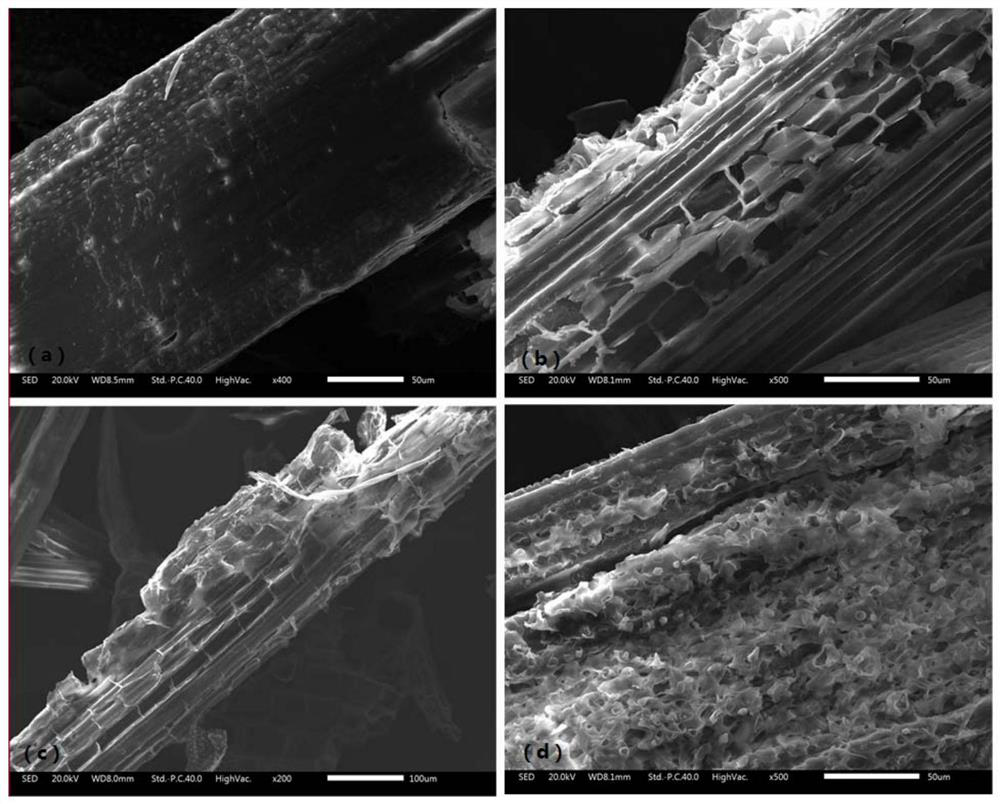A method of using lignin-degrading bacteria to strengthen the fenton reaction pretreatment of waste biomass
A technology of lignin-degrading bacteria and waste biomass, applied in the direction of microorganism-based methods, using microorganism/enzyme cellulose treatment, biochemical equipment and methods, etc., to achieve the effects of small secondary pollution, short processing time and simple operation
- Summary
- Abstract
- Description
- Claims
- Application Information
AI Technical Summary
Problems solved by technology
Method used
Image
Examples
Embodiment 1
[0029] (1) The rice straw was crushed and sieved with 60 meshes, washed twice with ultrapure water, and dried at 60°C until constant weight.
[0030] (2) Further put the waste biomass in a container of appropriate size, and add FeCl with a concentration of 0.02mol / L at a solid-to-liquid ratio of 1:10 (g / ml) 3 and 1.5mol / L of H 2 o 2 , shaken at room temperature for 2h, and separated by filtration to obtain wet residue A.
[0031] (3) The wet slag A obtained through filtration and separation was further rinsed repeatedly with distilled water until the pH of the rinsing solution was neutral, and dried at 60° C. to a constant weight to obtain dry slag B.
[0032] (4) Inoculate the B-8 bacteria stored on the LB slope into the LB liquid medium, and cultivate at 30° C. for 18 hours (the optical density at 600 nm reaches 0.8-1.0) to obtain the seed liquid of B-8; The distribution ratio of the components of the LB liquid medium is: 10 g of peptone, 5 g of yeast powder, 10 g of sodi...
Embodiment 2
[0039] (1) The rice straw was crushed and sieved with 60 meshes, washed twice with ultrapure water, and dried at 60°C until constant weight.
[0040] (2) Further put the waste biomass in a container of appropriate size, and add FeCl with a concentration of 0.03mol / L at a solid-to-liquid ratio of 1:10 (g / ml) 3 and 2.25mol / L of H 2 o 2 , shaken at room temperature for 2h, and separated by filtration to obtain wet residue A.
[0041] (3) The wet slag A obtained through filtration and separation was further rinsed repeatedly with distilled water until the pH of the rinsing solution was neutral, and dried at 60° C. to a constant weight to obtain dry slag B.
[0042] (4) Inoculate the B-8 bacteria stored on the LB slope into the LB liquid medium, and cultivate at 30° C. for 18 hours (the optical density at 600 nm reaches 0.8-1.0) to obtain the seed liquid of B-8; The distribution ratio of the components of the LB liquid medium is: 10 g of peptone, 5 g of yeast powder, 10 g of sod...
Embodiment 3
[0049] (1) The rice straw was crushed and sieved with 60 meshes, washed twice with ultrapure water, and dried at 60°C until constant weight.
[0050] (2) Further put the waste biomass in a container of appropriate size, and add FeCl with a concentration of 0.01mol / L at a solid-to-liquid ratio of 1:10 (g / ml) 3 and 0.75mol / L of H 2 o 2 , shaken at room temperature for 2h, and separated by filtration to obtain wet residue A.
[0051] (3) The wet slag A obtained through filtration and separation was further rinsed repeatedly with distilled water until the pH of the rinsing solution was neutral, and dried at 60° C. to a constant weight to obtain dry slag B.
[0052] (4) Inoculate the B-8 bacteria stored on the LB slope into the LB liquid medium, and cultivate at 30° C. for 18 hours (the optical density at 600 nm reaches 0.8-1.0) to obtain the seed liquid of B-8; The distribution ratio of the components of the LB liquid medium is: 10 g of peptone, 5 g of yeast powder, 10 g of sod...
PUM
 Login to View More
Login to View More Abstract
Description
Claims
Application Information
 Login to View More
Login to View More - R&D
- Intellectual Property
- Life Sciences
- Materials
- Tech Scout
- Unparalleled Data Quality
- Higher Quality Content
- 60% Fewer Hallucinations
Browse by: Latest US Patents, China's latest patents, Technical Efficacy Thesaurus, Application Domain, Technology Topic, Popular Technical Reports.
© 2025 PatSnap. All rights reserved.Legal|Privacy policy|Modern Slavery Act Transparency Statement|Sitemap|About US| Contact US: help@patsnap.com



